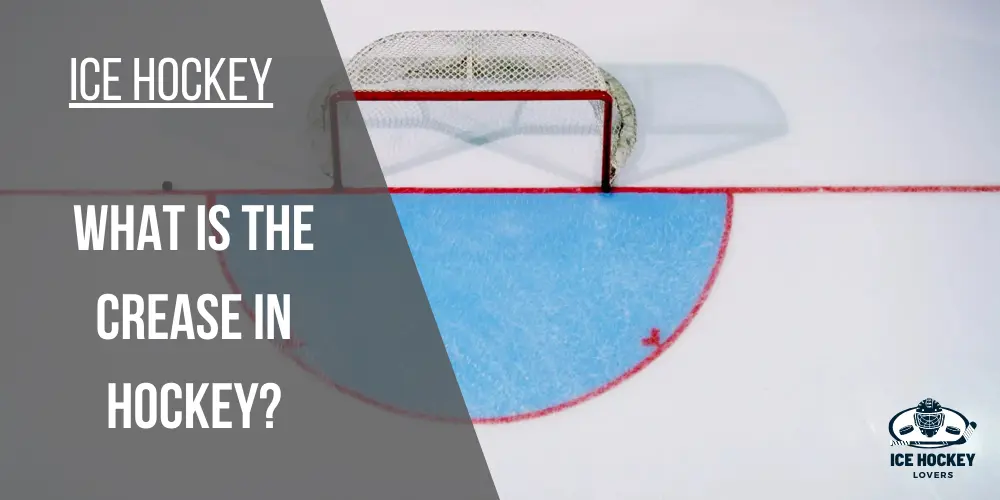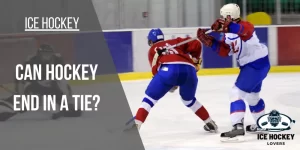Hockey Crease: What is the Crease in Hockey?

Have you ever seen that light blue area on the ice and wondered what that is? Besides being so beautiful in contrast with the white ice, it is also a particular area, the goalie’s area!
The goalie crease is the light blue shaded painted area ahead of the goalie’s net. As its name suggests, it is the goalie’s area and is essential to protect and act as a reference to position while saving the goals. The opponents can go into this goalie’s crease on the condition that they will not affect the goalie in stopping the puck.
This was not allowed earlier in history. Entering the goalie’s crease would disallow the goal. The NHL changed this rule in the 1999-2000 season.
Table of Contents
What is the purpose of the goalie crease in hockey?
So, what is the purpose of the goalie crease if any player can go in there? The goalie crease serves three essential functions:
- It acts as a reference for the goalies helping them in positioning.
- The goalie can freeze the puck in the goalie crease, which stops the play.
- Protects the goalies and maintains their safety.
These are the three significant reasons describing the importance of the crease. Let us discuss them in detail.
The crease: A reference for the goaltender
The most challenging job among hockey players is that of the goalie. A goalie needs to be mindful of his position. The crease helps the goalie in his correct positioning. The goalie has to keep shifting since hockey is fast-paced, and the players are in fast action.
The goalie must be able to predict the coming shot, but still, it is difficult to find an optimal place to stop the candid shots. This is where the goalie crease helps.
The goalie crease is a reference point for the goalie to fix his position. The net he has to protect is behind the crease, while the crease lines are ahead of him.
Usually, the goalie can stay at the top of the crease. This crease also helps them not to move far away from their position.
The crease: A place to freeze the puck
The goalie can also freeze the puck in the crease to stop the play on the condition that none of the opponent players is closer to him to maintain the game’s flow.
Goalies can also make saves by coming out of their crease. But the goalie cannot go out of his crease to freeze the puck and cause the game to stop.
If a goalie does this, he will face a two-minute penalty for delaying the game.
The crease: protection for the goalie
And the third function of the crease is to protect the goalie during the play when he makes the saves. Players cannot contact the goalie when he is in his crease. If a player does that, he will face a two-minute penalty, or there will be no goal call.
Even when the goalie is outside the crease, players cannot body-check him, but there is no penalty for accidental contact.
A goalie is considered in the crease even if only one of his skates is in the crease. If a player makes contact with him even in the slightest possible way, it will be an infraction with a minor penalty.
Goalie’s crease dimensions
The standard NHL goaltender’s crease is 8 feet wide, with two 4 feet sides, each connected by a 6-feet long semicircle at its apex, which connects the 4 feet long sides. The goal net is 6 feet wide, making a crease width one foot longer than the goal on both sides. The crease is a light blue shaded area outlined by a 2 inch red border.
Other rules around the crease
There are some other rules, too, regarding the crease. Some of them are:
- Players cannot enter the crease before the puck. The puck must enter first, or there will be a penalty.
- The defending team cannot take or cover the puck in the crease in any possible way. Doing this will result in a penalty shot to the other team.
- In case of a fight outside the crease, the goalie is not allowed to join it. He must stay in his crease or face the penalty.
Frequently Asked Questions
How big is the goalie crease?
The goalie crease is two-inch thick and four feet and six inches long. It consists of two lines joined by a semi-circle with six inches radius. The semi-circle is six feet away from the goal line.
International Ice Hockey Crease Rule
Players cannot go and stand in the crease intentionally without a purpose. If a player does this, the referee will blow the whistle, stopping the game, and there will be a faceoff in the neutral zone.
Brett Hull’s No Goal
Brett Hull’s No Goal is one of the famous crease violations that could not be called. It was done in the sixth game of the 1999 Stanley Cup finals. The Dallas Stars were leading three games to 2 when Brett Hull scored the goal and immediately started celebrating.
During that celebration, everyone went along and did not review the play. Upon replay, we see Brett Hull’s toe was in the crease, and this goal cannot be considered according to the rules.
Are defensive players allowed to cover the puck in a goalie’s crease?
Defensive players cannot cover, conceal or grab the puck inside the goal crease to assist their netminder. If this happens, then the attacking team gets a penalty shot.
Can a goalie leave the crease?
Goalies are allowed to leave the crease and play the puck in the trapezoid area. He can also skate and play anywhere on the ice as long as he does not cross the center red line. A minor 2-minute penalty will be called on him if he does that.
Is a goalie allowed to cover the puck outside of the crease?
Goalies cannot leave their crease just to cover the puck. They will receive a 2-minute minor penalty for a game delay if they do that. However, if a goalie makes a save and ends up outside the crease, they can cover the puck if the opposite players are in close proximity and attempting to play it.
Who can go inside the crease?
Goalies and players can both go inside the crease. But if players inside the crease disturb a goalie’s movement, they have to sit in the penalty box for 2 minutes.
What is a crease violation?
Any irritating and disturbing player cannot enter the blue area of the crease during the game. If he does that, no goal will be allowed inside.
Conclusion
The crease is a specific area for a goalie to play freely and protect the net from the puck. A crease is a goaltender’s protection from getting interrupted by other players so that he can focus on his game. Other players can enter the crease but cannot impede a goalie’s movement.
The goalie’s crease has changed in shape and size over the years, but it is always there to protect the goalie. In the 1990s, the major problem came with the crease when players were not allowed to go in it or put their sticks inside it. This created chaos, so the NHL eliminated the rule in 1999. The crease can again undergo a dimension change in the future, but it’s like a goal line that will never disappear and always be there.
Related Posts:

Who is Austin Taylor?
Meet Austin Taylor, your go-to source for everything ice hockey! With a passion for the sport that’s as deep as the ice itself, Austin Taylor brings you concise, expert insights and nitty-gritty details on all things hockey. From gear reviews to strategy breakdowns, Austin Taylor is your trusted guide to navigating the exhilarating world of ice hockey. Get ready to lace up your skates and dive into the game with Austin Taylor as your ultimate companion.





